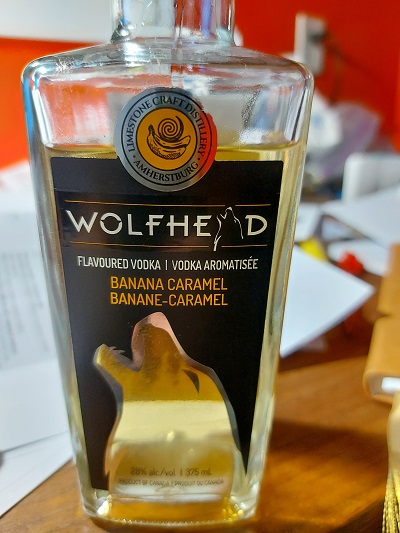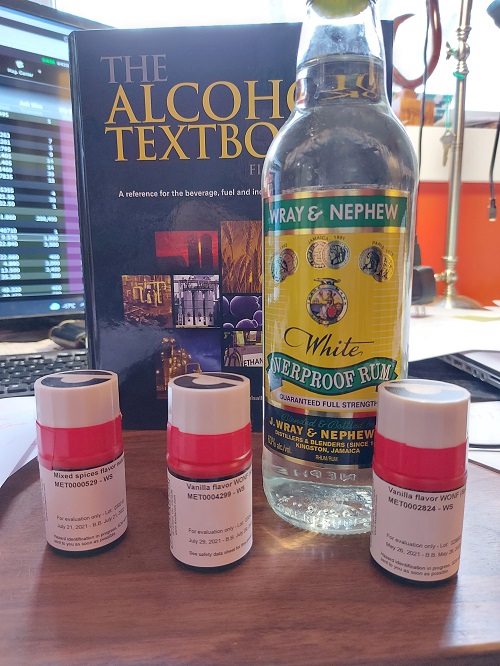
Here is another stunning example of a flavored libation. The banana and caramel notes are deep and robust. This is a real testament to the quality of flavoring compounds available to the craft alcohol industry.
As I enjoyed a series of Banana-Caramel + Egg Nog drinks last evening, I could not help but to feel sad for what the craft distilling industry has morphed into.
To be very candid, people who got into craft distilling certainly were brimming with passion. But they were lacking in scientific knowledge.
As the industry was emerging, I had the distinct advantage of spending time in Scotland pursuing my M.Sc. degree in Brewing and Distilling. I had the good fortune to be able to travel around Scotland. One day I had an oh-oh moment. Maybe it is better to say I had an oh-shit! moment. I suddenly realized that the world is drowning in alcohol. Distilleries I visited were cranking out 10, 15 and even 30 million liters a year using only a small handful of process operators.
Not long afterwards, in Canada I could sense the ground starting to shift. Craft distilling had aroused the sleeping bear. The big boys with their commanding market share woke up and started to fight back. They doubled down on their advertising and product creation efforts. At my house, my wife who enjoys my home-made Gin started coming home with bottles of Tanqueray Rangpur Gin. Initially I laughed this off. But then I tasted the Gin. Oooohh! The big boys can deliver a knock-out punch when they want to. The Gin was seriously good. I headed off in search of exotic citrus fruits to up my home distilling game. Thankfully I found a spice vendor in western Canada that provided me with what I was looking for.
Consumers then became enlightened. In the beginning, craft distilling was new and shiny. People wanted a piece of it. But as the big boys fought back with credibly good products, the consumer realized that there was no need to give up allegiance to the brand names. Besides, the brand names were cheaper.
Craft distillers then faced the dilemma of having to get prices down to counter the big boys. That is a tall order to fill when your rent plus equipment loans plus raw material costs can be north of $10,000 per month. For many craft players there was precious little wiggle room for price reductions.
So craft distillers started to embrace bulk ethanol made by large, industrial ethanol makers. These ethanol makers could provide the craft operator with vodka, whisky and even rum distillates at a cost of around $6 per liter. Cheaper than a craft distiller grinding his own grain or handling jugs of molasses could make it for.
As we get set to start 2022, I predict that the road ahead will be a rough one for craft operators who are financially ill-prepared. Covid has been tough on small business and it ain’t done yet. Add to this scenario the fact that the big boys have been stirred and riled up and they are not backing off.
Vodka is nothing more than ethanol and water diluted down to 40% abv. The market is drowning in vodka. The consumer will seek out a cheap vodka because they mix their vodka with something else. A craft distiller grinding his own grain and singing the virtues of being craft and grain to glass will find himself singing to an empty room.
Whisky in Canada is nothing more than a blend of 2 or 3 types of distillate (wheat, barley, rye, maybe corn…) aged for a handful of years. Factories in Lethbridge, AB, Gimli, MB, and Windsor, ON are cranking the stuff out 24-7. They know that Canadians are mixers. So, crank it out, market the hell out of it, and sell it out. Along the way maybe hire a blow-hard to name your Whisky the best in Canada. Hell – why stop there? Pay him more money and call it the best in the world. The consumer will lap it up like a kitten with warm milk.
Herein is a stellar opportunity for craft players. Make a deep, robust whisky expression. Why stop at one? Make several different expressions. Use the double pot distilling technique. Age it for 5 or 6 years in oak. The big players will not be able to challenge you. To do this will require some solid financial footing on your part. Time is money as the old adage goes. Barrels ageing at your distillery don’t pay you right away. A classic example is the just-released Rye Whisky from Tumbleweed Distillery in Osoyoos, BC. Expensive? Yes – its $85. Good? Damn straight it is. And you don’t dare ever mix this with coke or ginger ale. A tiny splash of water and your taste buds will be dancing happy with every sip. That’s what whisky appreciation is all about. Craft whisky offers serious potential….
Gin also presents another opportunity for craft players. The big boys tend to have a small portfolio of gins. Yes, they might be tasty, but it takes time to make them and concoct the marketing programs. A craft distiller can easily have a new gin recipe designed today and made tomorrow. Gin is a very personal thing. Some people like the aromas of citrus in a gin. Some like it a bit spicy on the finish. Some like to experience lavender notes on every sip. So – make one of each. Have an entire family of craft gins. Something for everyone. Yes, it will cost money to carry multiple gins in inventory. The cost of sourcing different labels and registering different SKUs with the liquor authorities all add up. But, if you stand on firm financial footing, you can make an impact.
Rum is another area to look at. When I was initially scoping out M.Sc. thesis projects I came to realize that there are a number of rum makers in the Caribbean cranking out rum distillate 24/7. They are only too happy to sell a licenced distiller some distillate. In 2018, one rum that was catching attention was BumBoo. I found a bottle and was pleasantly surprised at the bouquet of aromas. This was distillate from Barbados flavored with spice and flavor compounds, bottled and marketing very smartly. All by a group in New York State. As a craft distiller, perish the urge to start fermenting molasses and standing in front of a still. Buy the distillate and age it, flavor it, market it. Yes it will cost you money as your piece together your supply chain. Yes, it will take time. But, in the end it will all be worth it.
Cream based libations are another area to look at, but the playing field might be getting a tad crowded. Making cream based products demands some rudimentary knowledge of Stoke’s Law. Fat globules like to glom together and separate from the cream. Calcium casseinate will slow down the process.
RTD products have literally exploded across the beverage landscape. My first hint at the tidal wave coming was when I stopped at a Tesco supermarket near my hotel in Edinburgh. Every flavor and mixture of alcohol imaginable was in a can, carbonated and ready to drink (RTD). I urged people in my Workshops to jump on the RTD tidal wave. They yawned and looked at me glassy-eyed and said nope… we just wanna’ distill booze. Wow! Opportunity missed. The big buys are now muscling in on the scene and taking market share. For craft distillers, it may not be too late. Find some unique flavors that the big boys have overlooked. Go for it!
Flavored Vodkas leaves this story back where it started. The big boys have a vast array of flavored vodkas on shelves. But these vodkas are all clear. The flavors are all chemical in nature. They do this for mass-production product consistency reasons. A craft operator has a window of opportunity to source some natural flavoring compounds from places like Food Arom. The result can be something like the Banana Caramel libation pictured atop this post. You can bend and twist with ease, offering seasonal variations of flavored vodka. But, you will not be alone. All your competitors will be thinking alike. Money for marketing then enters the picture.
When I first set foot in the craft arena in 2013, I had high hopes. I had visions of craft distilleries grinding their own grain and thoroughly embracing the field to flask ideal. But, a lack of scientific knowledge presented an insurmountable barrier. You have to understand the science of food and drink if you are expecting a consumer to ingest your product. Chucking a bunch of un-hydrated yeast over your shoulder into a vessel of hot mash of unknown temperature just doesn’t cut it. Not being able to solve an algebraic expression so you can proof alcohol doesn’t fly. Craft has been shoved back into a corner. The big boys reign supreme. And the craft movement has itself to blame.
Can craft come out of its corner and fight another few rounds? Certainly it can. But, people have to embrace science. They don’t have to wander off in search of an M.Sc. degree. I can help anybody grasp the science. On the surface, it all appears daunting. It really is not. I can help you. Once you wrap your head around the science of what you are doing, you will be able to deliver a few stiff upper-cuts to the big boys. You will send them reeling back against the ropes.
If you are reading this post and contemplating an adventure into the craft beverage industry, I do hope we can cross paths at one of my 2022 planned 5-day Distillery Workshops to be held in Cawston , BC. The details are elsewhere on this website.
Even if you are not contemplating a full-blown craft adventure and just want to learn about beverage alcohol, one of my Workshops will raise your knowledge bar and make you a very discerning customer of beverage alcohol.
Cheers – see you in 2022




